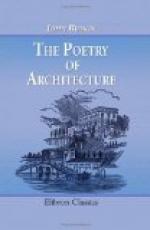41. But the winter residence, the Swiss cottage, properly so-called is a much more elaborate piece of workmanship. The principal requisite is, of course, strength: and this is always observable in the large size of the timbers, and the ingenious manner in which they are joined, so as to support and relieve each other, when any of them are severely tried. The roof is always very flat, generally meeting at an angle of 155 deg., and projecting from 5 ft. to 7 ft. over the cottage side, in order to prevent the windows from being thoroughly clogged up with snow. That this projection may not be crushed down by the enormous weight of snow which it must sometimes sustain, it is assisted by strong wooden supports (seen in Fig. 3), which sometimes extend half down the walls for the sake of strength, divide the side into regular compartments, and are rendered ornamental by grotesque carving. Every canton has its own window. That of Uri, with its diamond wood-work at the bottom, is, perhaps, one of the richest. (See Fig. 4.) The galleries are generally rendered ornamental by a great deal of labor bestowed upon their wood-work. This is best executed in the canton of Berne. The door is always six or seven feet from the ground, and occasionally much more, that it may be accessible in snow; and is reached by an oblique gallery, leading up to a horizontal one, as shown in Figs. 3 and 4. The base of the cottage is formed of stone, generally whitewashed. The chimneys must have a chapter to themselves; they are splendid examples of utility combined with ornament.
[Illustration: FIG. 3. Swiss Cottage. 1837.]
[Illustration: FIG. 4. Cottage near Altorf. 1835.]
Such are the chief characteristics of the Swiss cottage, separately considered. I must now take notice of its effect in scenery.
42. When one has been wandering for a whole morning through a valley of perfect silence, where everything around, which is motionless, is colossal, and everything which has motion, resistless; where the strength and the glory of nature are principally developed in the very forces which feed upon her majesty; and where, in the midst of mightiness which seems imperishable, all that is indeed eternal is the influence of desolation; one is apt to be surprised, and by no means agreeably, to find, crouched behind some projecting rock, a piece of architecture which is neat in the extreme, though in the midst of wildness, weak in the midst of strength, contemptible in the midst of immensity. There is something offensive in its neatness: for the wood is almost always perfectly clean, and looks as if it had just been cut; it is consequently raw in its color, and destitute of all variety of tone. This is especially disagreeable, when the eye has been previously accustomed to, and finds, everywhere around, the exquisite mingling of color, and confused, though perpetually graceful, forms, by which the details of mountain scenery are peculiarly distinguished.




